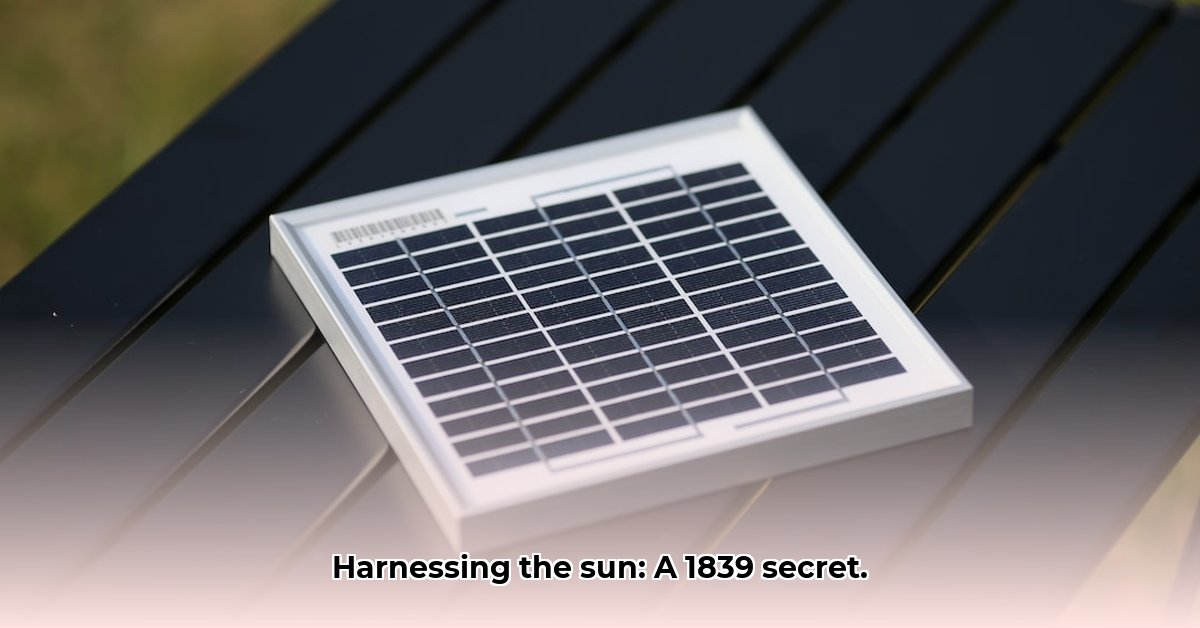Imagine a world without solar panels. Hard to picture, right? Before those sleek black panels graced rooftops, Edmond Becquerel, a French scientist, made a groundbreaking discovery. In 1839, long before widespread electricity, Becquerel found a way to turn sunlight directly into electricity. His simple experiment revealed the photovoltaic effect – the ability of light to create power. This article explores Becquerel’s achievement, his early experiments, and how his work paved the way for modern solar technology, showcasing the remarkable progress since his initial discovery. For more on solar energy’s impact, visit this site.
When Did Edmond Becquerel Discover Solar Energy? Unveiling the 1839 Discovery
Picture this: it’s 1839, a world without smartphones, the internet, or readily available electricity. In a Parisian lab, Alexandre-Edmond Becquerel made a revolutionary discovery: generating electricity directly from sunlight. So, when did Becquerel discover solar energy? The definitive answer is 1839. His work sparked the solar energy revolution, and his insights set the stage for future photovoltaic technology. Though it didn’t immediately produce usable solar panels, it illuminated the path for today’s technology.
Becquerel’s Simple but Groundbreaking Experiment: Illuminating the Photovoltaic Principle
Becquerel wasn’t aiming to create a solar panel; he was exploring the interactions between light and electricity. His experiment was elegantly simple: a basic electric cell with metal plates (electrodes) submerged in a slightly acidic solution, much like a rudimentary battery. He exposed this cell to sunlight and observed something astonishing: sunlight triggered an electric flow! The light produced an electric current. He unintentionally created a very early, inefficient solar cell, meticulously documenting the photovoltaic effect, marking the first observation of light transforming into electricity. This laid the foundations for modern solar energy applications.
Understanding the Photovoltaic Effect: From Light to Electricity Generation
The photovoltaic effect is the fundamental principle behind solar panels. Sunlight consists of tiny energy packets called photons. When photons strike certain materials, such as silicon or Becquerel’s platinum electrodes, they dislodge electrons. These freed electrons become electricity carriers, creating an electric current. Becquerel’s experiment proved the conversion of sunlight to electricity was possible, paving the way for technology that powers many homes today. How does this seemingly simple reaction revolutionize renewable energy resources?
From Tiny Spark to Global Industry: A Historical Perspective
Becquerel’s initial solar cell was extremely inefficient, generating a minuscule amount of electricity, barely registering on instruments. The scarcity of platinum and the cell’s inherent instability made its practical use challenging. It wasn’t a viable energy source at the time. Yet, his work was a critical first step, the starting pistol in the race to harness solar power efficiently. He provided a crucial blueprint for future breakthroughs, the theoretical groundwork for today’s technology.
A Technological Revolution: Comparing Then and Now in Solar Advancement
The difference between Becquerel’s device and modern solar panels is striking:
| Feature | Becquerel’s Cell (1839) | Modern Solar Cell |
|---|---|---|
| Efficiency | Less than 1% | Up to 25% |
| Materials | Platinum, silver chloride in acidic solution | Silicon, gallium arsenide and other semiconductors |
| Stability | Highly Unstable | Relatively Stable |
| Practical Application | Used to measure light intensity, phosphoroscope research | Widespread electricity generation, powering homes, businesses, and more |
The journey from a tiny, unstable cell to efficient panels is a testament to human ingenuity. Decades of research, development in materials science, manufacturing, and a deeper understanding of semiconductors have made all the difference.
Becquerel’s Lasting Legacy: Inspiring Future Innovation in Solar Energy
While Becquerel’s 1839 experiment didn’t immediately lead to solar-powered homes, its importance is undeniable. His discovery acted as a catalyst, inspiring generations of scientists to explore and refine the process, demonstrating the fundamental possibility of turning sunlight into efficient, clean energy. His legacy continues in ongoing research and improvements to solar technology, constantly pushing boundaries. He provided the seed of an idea that has blossomed into a global industry. Next time you see a solar panel, remember Alexandre-Edmond Becquerel and the pivotal moment in 1839 that set the stage for this clean energy revolution. His initial work made everything possible.
How Did Becquerel’s Early Photovoltaic Cell Compare to Modern Solar Panels? Efficiency and Technological Gap
Key Takeaways:
- Edmond Becquerel’s 1839 discovery of the photovoltaic effect was a foundational moment, laying the groundwork for modern solar technology.
- Given the technological limitations of the time, Becquerel’s early device had incredibly low efficiency. It demonstrated the principle, not a practical application.
- Subsequent advancements in materials science (selenium, silicon) drastically improved efficiency. Albert Einstein’s explanation of the photoelectric effect further enhanced understanding.
- The 1970s energy crisis spurred significant investment, accelerating solar panel development and adoption.
- Modern solar panels boast significantly higher efficiency, durability, and cost-effectiveness than Becquerel’s original cell.
Becquerel’s Groundbreaking Experiment: Setting the Stage for Future Solar Innovations
Imagine a world without solar power or the understanding of how to capture it. Hard to picture, right? Yet, the journey to our sun-powered present began with a simple experiment in 1839. Edmond Becquerel, a French physicist, made a remarkable observation: shining light onto certain materials caused a small electric current to flow. What makes this scientific breakthrough significant in today’s world? This was the discovery of the photovoltaic effect—the conversion of light into electricity, marking the true beginning of renewable energy possibilities.
The Dawn of the Photovoltaic Cell: A Comparison of Old and New Technologies
Becquerel’s “solar cell” was rudimentary, using electrodes immersed in an electrolyte solution—a far cry from today’s sleek silicon panels. So, how did Becquerel’s early photovoltaic cell compare to modern solar panels? The answer lies in the vast difference in efficiency. His device produced a minuscule amount of electricity, a proof of concept, not a practical energy source. Furthermore, the materials he used, while effective for demonstrating the principle, were not scalable or cost-effective for widespread use.
The Long Road to Efficiency: Gradual Progression in Solar Technology
The path from Becquerel’s discovery to today’s high-efficiency solar cells involved many incremental improvements and breakthroughs. The invention and utilization of selenium cells and silicon cells provided significant efficiency boosts. By the mid-20th century, these cells demonstrated noticeably higher efficiency and greater practical potential. Scientists and engineers worked tirelessly to refine the materials, designs, and manufacturing processes to continually improve performance and reduce costs.
Einstein’s Role: Theoretical Foundations of Photovoltaic Energy
Albert Einstein’s explanation of the photoelectric effect in 1905 provided a crucial theoretical framework. His work helped scientists understand why the photovoltaic effect occurred at the atomic level, guiding further advancements in materials and design. Einstein’s insights provided a roadmap for optimizing solar cell performance and unlocking the full potential of this renewable energy source.
The Energy Crisis and the Solar Boom: Catalysts for Solar Advancement
The 1970s oil crisis acted as a major catalyst, highlighting the world’s dependence on fossil fuels and spurring significant investment in renewable energy research, including solar energy. Did this investment ultimately pay off? The result was major advancements in solar cell technology, making them more efficient, durable, and cost-effective. Government policies, incentives, and growing environmental awareness also played a critical role in driving the growth of the solar industry.
From Lab Curiosity to Global Power Source: Solar Energy’s Journey
The evolution of solar technology is a testament to scientific perseverance, showing the power of incremental progress. Becquerel’s discovery sparked a chain reaction, leading to the development of solar panels now used for generating electricity on a global scale. The transition from Becquerel’s basic device to modern, high-efficiency panels illustrates how a fundamental scientific principle can be translated into technology with widespread practical application.
Becquerel’s Photovoltaic Effect: Limitations and Subsequent Advancements in Solar Cell Technology Challenges and Opportunities
Key Takeaways:
- Edmond Becquerel’s 1839 discovery of the photovoltaic effect, though groundbreaking, was limited by low efficiency and a lack of understanding of the underlying physics.
- Subsequent advancements, driven by theoretical breakthroughs like Einstein’s photon theory and material science innovations, significantly increased solar cell efficiency and enabled mass production.
- The development of the silicon solar cell in 1954 proved pivotal, paving the way for widespread adoption, though challenges related to cost and scalability remain.
- Geopolitical events and economic factors have greatly influenced the trajectory of solar technology development and deployment.
- Ongoing research focuses on improving efficiency, durability, and cost-effectiveness of existing and emerging solar cell technologies.
Becquerel’s Dawn: A Revolutionary Observation with Initial Constraints
Imagine a world before widespread electrification, where energy sources were limited and often unreliable. Then, in
- Wind Turbine Fire: Questions About Safety Spark Debate - October 31, 2025
- Vertical Axis Wind Turbine Design: Improving Efficiency and Overcoming Limits - October 29, 2025
- Wind Turbine to Power Home: Nacelle Design Improvements Advance - October 26, 2025
















